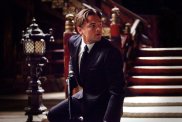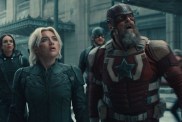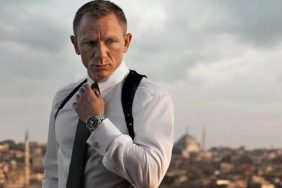I wasn’t a fan of The Living Daylights (1987) and was ready to call Timothy Dalton’s time as 007 a complete write-off. But something about Licence to Kill pulled me in and didn’t let go. It was a vastly different type of adventure for James Bond, showing a side of the character that fans had rarely seen up to that point. But grit, intensity, and a change of pace don’t always equal success.
Licence to Kill is James’ 1989 brutal drug-fueled revenge story. He was supposed to be on vacation, but even when he’s not on assignment, the dutiful agent arrests an elusive and abusive drug lord. After escaping authorities via a bribe, however, Franz Sanchez (Robert Davi) takes his revenge on Felix Leiter (David Hedison) by killing his new wife, Della Churchill (Priscilla Barnes), and having a shark bite off the DEA agent’s leg on his wedding night. As a callback to On Her Majesty’s Secret Service (1969), we’re reminded that Bond’s wife died on their wedding night as well, so James is taking this attack on his friend – and probably more Della, since it looks like those two had an odd and close relationship – real personally.
This film is one of those 007 features where the cold open is directly connected to the main story, and after a less-than-memorable opening theme, the rest is quite the ride. Bond had one job: don’t go rogue, but that’s exactly what he does — back before that was a common occurrence. The movie was originally titled “Licence Revoked,” but producers thought American viewers wouldn’t get the meaning, and test audiences were associating it more with a driver’s license. Maybe we are that dumb, but I’d like to think not.
Since this is a revenge romp, Bond doesn’t hold back from vicious and creative kills straight out of a slasher. Sharks, maggots, and electric eels are just the start when we have forklifts, grinders (processing machines), and decompression chambers, all before our explosive ending. There is a lot of underwater action, plane maneuvers, tanks, and the big finale used 16 big rig trucks, some of which were tricked out for specialized stunts.
The story itself is somewhat simple, and there’s a good argument that any hero could have gone on this journey. However, it acts as something different for Bond, stripping away some of the classic tropes of the franchise and doing a new story that still took from the source material. Some elements were taken from Ian Fleming’s Live and Let Die and The Hilderbrand Rarity, while movies like Kurosawa’s Yojimbo helped shape the second half of the story. I love how Bond infiltrates Sanchez’s operation and sows discord, turning him against his own men with some elaborate setups and a little luck.
Licence to Kill reminds viewers to never get married, should the find themselves in a 007 film. Although Bond has lost many of his acquaintances, this incident hit a passionate cord for him. These stakes make the film’s stakes feel more personal. It originally had a different plot and was going to film in China, but cost-cutting measures and realizing other movies had already used some of the locations they wanted to shoot ushered in changes. Also, due to the 1988 Writer’s Guild strike, series scribe Richard Maibaum did not continue to work on the story. This meant writer Michael G. Wilson was tasked to finish the script by himself.
For many fans, this is peak Bond characterization, and somewhat closer to the books with Dalton’s cold-blooded depiction. He’s (almost) more vulnerable here in contrast to his tough and savage exterior, not his usual suave perfect self. He messes up, takes unnecessary risks, gets caught, and keeps telling his allies he wants to do this alone so he doesn’t risk losing anyone else. Licence to Kill helps uplift the character of Bond out of a long period where many didn’t take him seriously, helping to shape the future of the franchise. Dalton was determined to make this performance count and even did a number of his own stunts, to the point that several members of the stunt crew were yelled at for letting him do too much.
Every hero needs a solid villain. Taking inspiration from the Fleming novels, that baddie should be a mirror — a reflection with darker ambitions — of James Bond. Sanchez is a different caliber of criminal for the MI6 agent. He isn’t striving for world domination or out to shape the globe, as much as he just wants to control the drug trade. Loyalty and honor seem to be most important to him, even if in a twisted sense, and he always pays his debts – he wants to trust Bond, be friends with him – but I’m not sure Sanchez knows what the word ‘personal’ actually means. This man has power, influence, and he likes to leave bad jokes with his victims, but Davi plays him so smoothly that it’s hard not to see him as a serious threat.
Bond may be on the outs with his government, but that doesn’t mean he’s doing this completely alone. He has the help of his ally and quartermaster, Q (Desmond Llewelyn), who normally hates fieldwork, but 007 is a special case. We see some excellent moments with this character, more than in any of the previous movies. It’s just sad that the gadgets are almost a little goofy, often feeling like they belong in other installments, not practical or fitting the new tone. I do like to think that M (Robert Brown) knew what Moneypenny (Caroline Bliss) and Q were doing, helping James by not stopping them.
As always, there are the Bond girls. We first meet Lupe Lamora (Talisa Soto), who doesn’t just have a great name but wants to be rid of her boyfriend, Sanchez, and she’s willing to align herself with Bond to make it happen. Lamora is skilled with seduction, dealing cards, and enjoys trying to manipulate others, especially when she realizes that Pam Bouvier (Carey Lowell) is also crushing on James. Bouvier is tough — an ex-Army pilot turned informant. She’s used to dealing with a rough crowd, but offers a different side later on when she shows off that stunning short hair and takes a cue from Lupe, seducing Professor Joe Butcher (Wayne Newton). Both of these actresses get a little bit of flack for their performances, especially Soto for her line reads, but I like to think she was hamming it up, poking at Pam. They’re both good in their own ways and play parts that enhance the story.
There are other supporting characters, people who have their own missions. Bond doesn’t care because he wants revenge, but these other conflicts come into play and matter, even if only for a moment. We see a young Benicio del Toro running around as Sanchez’s main henchman, Grand L. Bush as a DEA agent, and Cary-Hiroyuki Tagawa as an undercover policeman from Hong Kong. Del Toro most likely doesn’t need an introduction, and most won’t recognize Bush by name, but along with Davi, they make up the duo of Agents Johnson and Johnson from Die Hard (1988). Bush would also go on to star in Street Fighter (1994) as Balrog, while Soto and Tagawa would take on Mortal Kombat (1995) as Princess Kitana and Shang Tsung, giving us a trio of excellent video game combatants.
Kind of as a cameo, the theme song, Licence to Kill, is performed by Gladys Knight and uses some of the horn line from the theme to Goldfinger (1964). This was enough of a riff that royalties had to be paid out, but such was the intention, as it was meant to pay homage to the film. It isn’t bad, just not as memorable to me, same goes for the film’s score by Michael Kamen. The song I always associate with this movie is If You Asked Me to by Patti LaBelle, which plays over the ending and credits, but it seems like people know this one more for the Celine Dion version. Ignore the winking fish and just enjoy the tune.
As much as I enjoy this film and rank it quite high on my list of Bond movies, it does have some issues. I mentioned Q’s gadgets, but there are other tonal quirks, like casting Barnes as Leiter’s wife. The star of Three’s Company just didn’t quite feel right in the role. No, I have no clue why the Chinese operatives were dressed like ninja. (I just assume every government group has a version of them in espionage films, weird sound effects included.) As good as the action is – parts of it inspired scenes in Christopher Nolan’s Batman films and True Lies (1994) – the bar fight is a little ridiculous. The tanker truck going up on two wheels and doing a wheelie is also dumb, and not at all practical, but I kind of love it.
The end is also so much fun until the bad guy dies. Everything ramps up quickly, even though the movie is a bit long (2h 13m), but once all of the explosions stop, the story is wrapped up too quickly and neatly. Felix calls James from the hospital and seems happy, eyeing his attractive nurse, even though he’s down a leg, a wife, and a good friend, Sharkey (Frank McRae). Almost as a side thought, he informs Bond the British government says going rogue is cool, and they can talk about getting his job back. How awesome would the ending have been if Leiter thanked his friend for killing Sanchez but told him it wouldn’t bring back his dead lover, and Bond’s future was left up in the air to be dealt with in the next film, or at least made it seem like he was in trouble still.
The production did have some trouble of its own, having to edit several parts down to keep that PG-13 rating, which set a new standard for Bond films. The censored violence wasn’t restored until years later with the Ultimate Editions for home release. During the filming, David Hedison had a limp due to a mishap with the parachuting stunt, but maybe that’s the leg his character lost. While filming some of the action for the climax, Timothy Dalton and others were almost severely injured, but thankfully, everyone was alright, and some clever editing saved the shots. Some of the action we see on screen wasn’t intentional, and one of the missiles misfired, going off course. There’s also a photograph from the set of a flaming hand reaching out of the explosion, and the locals (as well as some of the crew at this point) think that area is haunted.
Thankfully, the film was finished and director John Glen says he thinks it is the best Bond film out of the five he helmed for the franchise, so he should know. The box office didn’t necessarily agree, at least in the U.S., but it made more money in other places, even if it is often referred to as the least successful movie in the series. Some think the serious tone and violence scared audiences away, others believe the trailers weren’t marketing it well (valid), and there was also the notion that it was just too different compared to previous entries. To make matters worse, it was released during a loaded summer against movies like Batman (1989). Yet, future installments would take notes from this adventure, and years later, many people have reconsidered their stance on Licence to Kill.
It was a huge change for the franchise. Dalton was supposed to do a third film that was already in the planning stages, but legal issues with the studio kept that project in limbo until his contract ran out, and he wasn’t looking to sign back on for multiple movies. This also saw the exit for many of the mainstays behind the camera who had been pushing the franchise forward for several years, truly putting a fine point on the end of that era. It was a sign of the hero to come, but they may have been trying to fly too close to the sun too soon. Not the Bond we wanted but the one the future needed.










